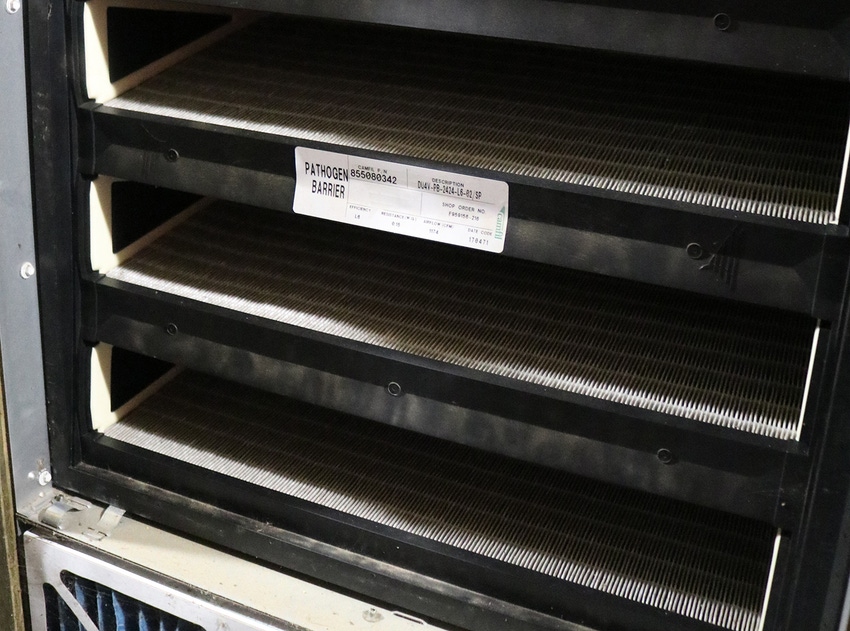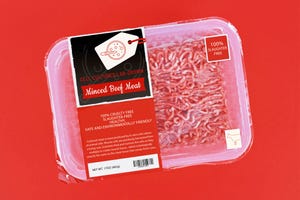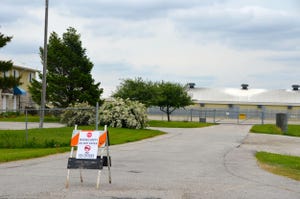Filtering efficiency
Knowledge of proper filtration continues to grow as viruses continue to challenge the swine industry.

Filters in hog barns are nothing new, but what has evolved is the knowledge base behind the development and testing of filters to keep the swine herd healthy.
Montserrat Torremorell, associate professor in the Uni-versity of Minnesota College of Veterinary Medicine Department of Veterinary Population Medicine, says disease transmission, how viruses get transmitted in the air and how important airborne transmission is have always been of great interest to her. This interest fell into place when she became the director of the Swine Disease Eradication Center after Scott Dee left the university.
Dee, a veterinarian now with the Pipestone Veterinary Services and the director of Pipestone Applied Research, had focused research on the transmission and biosecurity of the porcine reproductive and respiratory syndrome virus for a 12-year period while at U-M CVM.
Torremorell carried the torch that Dee had lit. “He had done a lot of work with filtration, and filtration was at the core of the projects the center had been funding,” she says. “Even though when he [Dee] left we thought we had the answers, we still had a lot of questions to address — and one of those questions was what particle size the viruses are associated with, and how good are the filters at removing viruses based on that particle size.”
She admits that filters had been tested for viruses, but the tests had not been using some of the standards for the American Society of Heating, Refrigerating and Air-Conditioning Engineers. Collaborating with the Center for Filtration, also at U-M in Minneapolis, Torremorell says it was important to validate the methods for filtration, developing procedures and protocols to calculate and measure what particle sizes that viruses are associated with, and “what removal efficiencies the filters would have for the viruses, based on the particle size.”
In addition to validating methods for filtration and study of viral particles, Torremorell’s team also took to testing used filters, which was prompted by producers and filter companies “calling and asking specifically, how did the filters perform for PRRS and or influenza?”
Torremorell says this was around 2012, so while filtration wasn’t particularly new to the swine industry, “producers were getting more educated about how to go about selecting filters, challenge synthetic filters and mechanical ones, or fiberglass-type filters.”
Particulars of particle size
In addition to looking at different media for filters, Torremorell and her team of researchers set out to find the efficiency of particle removal by filters, to be able to offer producers confidence in choosing the proper filters for their barns. “But one of the questions that keeps, or kept, coming up, was what particle size the PRRS virus associates with — because what the filters do is they remove particles from the air. But efficiency of removal of the virus depends on the size of the particle, so usually, larger particles are removed more efficiently, and smaller particles less efficiently,” Torremorell says.
That is where the minimum efficiency reporting value rating comes into play. The higher the number MERV rating that a filter has, the more efficient it is at removing particles. Filters of MERV 14, 15 and 16 were the main ones tested.
Torremorell stresses that the size of the PRRS particle, or whatever virus particle being discussed, is not necessarily important, but rather the size of the particle that the virus is attaching to. “It’s true we know the size of the virus particle can be very small, but the reality is that when viruses are transported through the air, usually they associate to a particle which can be water droplets, dust, nasal secretions or fecal material,” she says, “So then the size of the virus itself is not that important. What is more important is the size of the particle that the virus associates with.” She further explains that when virus particles are alone, they are more susceptible to more easily being neutralized; but when attached to a particle, the virus appears to be more protected.
Torremorell’s team has looked at PRRS, influenza and porcine epidemic diarrhea virus particles, and the efficiencies of filters stopping those particles.
To find the best filter for producers to use, Torremorell says work was done in the lab, as well on farms and collecting samples from the field, to “try to extrapolate that to the efficiency that the filters already have.”
The U-M team has also tested filter prototypes for companies looking to bring a new filter to the market.
Building on existing research
Nikki Goss, biological safety and research manager for AAF Flanders, wants to expand on the work that Torremorell’s team has done by bringing it to her company’s Clean Air Innovation & Research Center in Jeffersonville, Ind. With a background in microbiology, mainly working in food science and quality assurance in food systems, Goss brings that knowledge of the scientific method to look at making the best filter for hog producers. “I am not an engineer, but by aligning myself with Bernard Olson, I was able to get a better understanding of the engineering portion of the testing done at the university,” she says. Olson is the director of the Particle Calibration Laboratory in the U-M College of Science and Engineering, and also collaborated on a 2015 study done with Torremorell’s team to determine if a standardized testing method was effective at analyzing air filters for the PRRS virus.
Goss is collaborating with Torremorell and Olson to further her own research.
Goss’ goal of research is to be able to back up the claims of filters’ overall performance, as well as assess remaining efficiency against viruses such as PRRS and PEDV, “providing another layer of customer support and reliability for our products.”
On that note, she is performing individual aerosol tests on AAF Flanders filters against these target agents, “so that we can, with surety, tell our customers past, present and future that yes, our filters work against these agents.”
Goss admits the sales byproduct from her research would be great for her company, but “for me as a scientist, I am truly concerned about the health of the herd, because I know it’s a big economic investment for producers to install filtration. For this reason, we want to be sure that our filters perform on a level that our customers expect in order to protect their investment.”
When AAF Flanders engineers develop a new filter or filter media, Goss will be able to put the potential new product up against aerosolized virus particles to get a virus removal efficiency. “I’ll be able to test new and existing products using this technology at the Clean AIR Center.” The Clean AIR Center’s biological laboratory is a Biosafety Level 2, meaning that Goss can work with the PRRS and influenza viruses, but she collaborates with Bob Rowland and Megan Neiderwerder at Kansas State University in order to perform investigations requiring a higher level of containment for research. The Biosecurity Research Institute at KSU has Biosafety Level 3 facilities, where research of this nature can take place.
Currently the Clean AIR Center’s lab is fully operational to test for PRRS and mold, with progress being made to be able to test for PEDV, influenza A and Mycoplasma hyopneumoniae. Just as in the U-M lab, Goss’ research goes beyond identification and quantification of virus, also performing standard tests for pressure drop and overall efficiency. Goss, since coming on board with AAF Flanders in August, has implemented interdisciplinary virus testing protocol, requiring both biological and engineering expertise (particularly aerosol science). “I therefore collaborate with our engineering team in order to pair the standard ASHRAE tests for pressure drop and efficiency with the virus removal efficiency test, and from that, we can report combined results to our customers.”
Wanted: Used filters
Goss is looking for hog barn filters — and she wants a lot of them. “I want to be able to test as many used filters in the U.S. that I can,” she says, “to be able to build a database and hopefully develop a method to determine the time point when a filter uses up its viral efficiency.” She realizes acquiring enough used filters to be statistically valid will not happen overnight. “We’ll need 20 to 30 [filters] at each year of age,” she says. “It may take a while to get enough of the four-year, five-year and six-year groups. … it may take two to three years to complete this study.
“My hope is that through this study, a logical time point can be established in which we can say with confidence that at this time point, it’s recommended to change your filter based on your geographic location and the density of swine in your area,” she says.
She has reached out to integrators to acquire filters that have been replaced from barns. In this open “curtain call” for used filters, Goss realizes that filters from other manufacturers may find their way to the AAF Flanders lab. That’s fine by her, and she hopes the competition will also welcome that for the good of the swine industry. “The ultimate goal is to do what we can to ensure the health of the herd.”
About the Author(s)
You May Also Like



